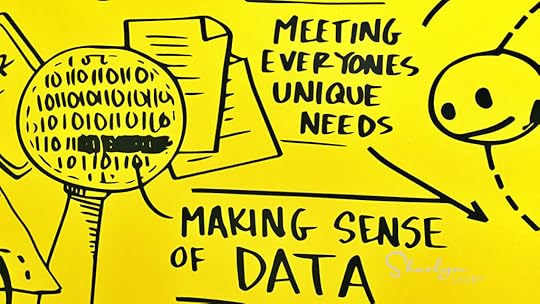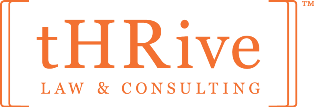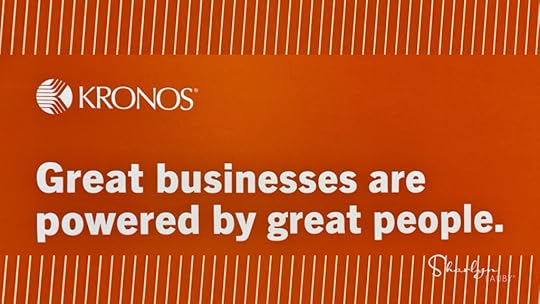Sharlyn J. Lauby's Blog, page 79
August 11, 2020
6 Key Principles for Organizational Decision Making

Organizations are always making decisions. And when faced with unique circumstances, they might have to make some more – including some really tough ones. Decision making isn’t easy. Some people avoid making decisions at all costs. And avoidance is a decision in itself. There are times when the outcome from no decision can be worse.
At some point last year, I attended a conference where the speaker shared six principles for decision making. And I have no excuse for not knowing which conference and the name of the speaker. Please forgive me! But I found my notes from the event, thought the principles were good, and I’d like to share them with you.
Be Consistent. Organizational decision making is a process. For example, if the company typically gets a focus group of customers together when rolling out a new product. Then not doing that could appear to be odd to customers. Use a consistent process for reaching and communicating decisions. It helps people know what to expect from the organization.
Support organizational values. I know this sounds obvious, but any decision the company makes should align with the company’s core values. When the company makes resolutions that don’t appear to align, people will question it. If the company can explain it, then great! But if they can’t, then sometimes human nature is to suspect the worst.
Align individual and company goals. Speaking of alignment, organizational decisions also need to be able to align with employee goals. Deciding something about the company will usually impact performance goals. Most of us work in organizations where the company’s goals are the department’s goals which then become the employee’s goals.
Make decisions future focused. This ties into number three. When we talk about decisions, they should be focused on the future. I’ve been in situations where something happens in the organization and senior management decides they don’t want that to happen again. So, they decide a policy needs to be written about the past event. They should be talking about what they would like to see in the future.
Communicate decisions in a positive way. I remember years ago, someone saying that HR departments were really “The Department of No”. It stuck with me. When it comes to company communications, we don’t need more “no” policies. Organizations should communicate what employees “can” do and how they can be more successful.
Assign accountability. When decisions are made, consider using a model like RACI (responsible, accountability, consult, and inform) to improve the implementation of the decision. It’s not enough just to make the decision. Or to simply communicate it. The organization needs to make sure that what has been decided actually happens.
Whether organizations make decisions that are perceived wonderful, fabulous, and loved by everyone or sad, awful, and sure to upset most, companies need to make sure that what you decide is consistent with the organizational belief system, communicated clearly, and implemented properly. Having a few principles in place can help companies reach consistent decisions so that, even when the conclusion isn’t loved, everyone can understand it.
P.S. Speaking of decision making, one of the biggest evaluations that organizations make involves the technology they use. The HR Technology Conference & Expo has decided to go virtual this year. And the event is FREE (but registration is required)! The event will be held October 27 -30, 2020. Same great speakers and an opportunity to learn more about how technology can transform your organization. This decision is a no-brainer so be sure to check it out!
Image captured by Sharlyn Lauby during the HR Technology Conference & Expo in Las Vegas, NV
The post 6 Key Principles for Organizational Decision Making appeared first on hr bartender.






August 9, 2020
The Boss is Bullying Us While We Work From Home – Ask #HR Bartender

This reader note reminded me that just because you work from home doesn’t mean you’re immune to a toxic work culture.
Before Covid-19 sent us to work from home, my boss had issues with creating a hostile work environment (i.e. complaints from multiple employees to HR). Also, my boss has had mandatory training and had to go to mandated counseling with another one of their direct reports. As a result, the company started to restructure the department, essentially stripping my manager of their supervisory duties.
There’s been a delay in the restructuring. The company is blaming it on Covid-19, which is understandable to an extent. However, my boss has continued their behaviors, including belittling workers. I leave our one-on-one Zoom meetings feeling like garbage.
Currently, we currently do not have a date to physically return to the workplace. What standing do we employees have against this bully? Any advice would be super helpful and appreciated as I am at my wits end.
I don’t want to dismiss the term “hostile work environment” here, but this reader note mentions bullying and toxic behavior more, so I’m going to initially assume that the boss is a big jerk. We’ve written before on HR Bartender about some things that employees might want to consider when working in a toxic work environment.
My Manager is Threatened by Me – An HR Bartender reader writes that they work for a manager who is threatened by them. We discuss how to deal with workplace issues.
How to Tell If Your Boss Is a Bully or Just Tough – We should not ignore bullying claims when a boss just says they are giving tough love. We need to make an objective and honest evaluation.
While there’s nothing wrong with expressing your concerns to HR (in fact, you should), some employees try to handle the situation on their own before getting others involved. Here are a couple of articles that might help.
How to Confront a Trash Talking Manager – What can an employee do when they hear their manager trash talking them behind their back? Our friends from the law firm of Foley & Lardner offer some advice.
Ethics: Taking Credit For Someone Else’s Ideas – Ethics in the workplace is important to employees. It builds trust and engagement. Here are some tips to create an ethical culture and hold others ethically accountable.
Even when an employee does all the right things, there are times when either 1) the situation escalates to harassment and a “hostile work environment” OR 2) it’s unbearable and others need to get involved. While I hope it doesn’t get to this point, employees might find these two articles helpful when taking next steps.
Reporting Workplace Bullying to HR – HR needs to know when bullying takes place in the workplace. So, when any employee knows about workplace bullying, they should report it directly to HR.
Employees: When Should You Lawyer Up – Employees may need a lawyer at some point in their career. To help understand why and when you may need a lawyer, these legal experts offer some guidelines.
I know there’s a lot to unpack here. These types of situations are always complex and have many unique nuances. The key to successfully navigating the situation is UNDERSTANDING what’s happening, DETERMINING what you want as a result, and COMMUNICATING the matter to the right people. And that applies whether you’re working in the office or at home.
Image captured by Sharlyn Lauby while exploring the streets of Salt Lake City, UT
The post The Boss is Bullying Us While We Work From Home – Ask #HR Bartender appeared first on hr bartender.






August 6, 2020
Employee Experience: Digital Transformation Can Improve It

Digital transformation is the concept of using technology to solve business problems. As business strategies become more global and organizations need to be more agile, it only makes sense to use technology to our greatest advantage.
Over the past few months, I’ve shared with you a few articles that I worked on with our friends at Paycom about digital transformation and how it can positively impact the employee experience. While I hope you enjoyed each of the articles as you read them, I thought you might like to see them together and how they connect.
5 Ways Strategic HR Can Bring Business Value
HR’s strategic role is to help the organization solve their people challenges. Because when we do, that benefits the bottom line. The first rule of solving business problems is to get buy-in. Not only from senior management but from employees. Because if employees don’t buy-into the solution…then the problem didn’t really get solved.
Improve the Employee Experience by Providing Answers
HR departments have the opportunity to take a cue from their marketing counterparts and create employee experiences that resemble the customer experience. And the good news is most employees are customers (somewhere), so the adoption rate should be significant, which brings immediate value to everyone involved.
Managers: Reduce Paperwork to Spend More Time with Employees
While we need paperwork for compliance and back-up, a manager’s job shouldn’t be all paperwork. Organizations want managers to spend more time building good work relationships with employees because the employee experience is important. We rely on managers to deliver a great employee experience. So, we should give them the tools they need to get the job done.
I believe organizations are spending a lot of time right now establishing their business priorities. That includes their talent strategy. Being able to communicate with employees via technology only makes sense.
Employees are very used to communicating with family and friends via social media and platforms like Zoom. Giving employees an experience that’s similar to the one they use at home can be a win for everyone. User adoption increases because employees know its effectiveness. The learning curve decreases because its similar to something they already use. The end result is effective communications, which benefits the organization at every level.
The post Employee Experience: Digital Transformation Can Improve It appeared first on hr bartender.






August 4, 2020
Working From Home Version 2.0: 5 Things to Consider

When COVID-19 started making headlines and employees were working from home, the idea was that this was all temporary. In a few weeks (or months), life would return to normal and we’d all be back in the workplace. That hasn’t exactly happened. In fact, many organizations are telling employees they can stay home for the rest of the summer, year, or forever.
If you’re in one of these situations where your working from home is being extended, it might be time to think about your office set-up. When we were talking about lasting a few weeks, we say to ourselves that we can make sacrifices. The longer this situation lasts, the more we need to consider a longer-term solution. Think of it as “Working from Home Version 2.0”.
I ran across an article in The Washington Post titled “As the pandemic continues, it might be time to upgrade that temporary home office setup”. While the article was a bit more form over function, it got me thinking. What are the handful of items in my home offices that I wouldn’t want to live without?
A good chair! This is without a doubt number one on my list. Sitting for hours in an uncomfortable chair is the worst and it doesn’t help you do your best work. I’m very fortunate. I have a Herman Miller chair that is beautiful and great for my posture. You don’t have to buy the most expensive chair on the market but do think about making your back and neck happy with a good chair.
Computer monitors. Everyone’s taste in computer monitors is different. Some people want one big monitor. Others might like a couple of smaller ones. Personally, I have three and I love it. If you’re accustomed to working on a laptop, maybe it makes sense to have one monitor and use your laptop as a second one. Regardless, if you’re not traveling, then having a larger monitor is great for your eyes (and neck).
Lighting. Speaking of our eyesight, it can be nice for our eyes and our mental health to have a workspace near natural lighting. My home office has a lovely view of our garage door – LOL! But at least, I can see outside and can enjoy the sunshine. If you’re not able to set up a workspace near a window, try to find some good lighting that will make reading easier.
Storage. In the workplace, we have access to supply cabinets with all of the things we need like ink cartridges, pens, paper, staples, etc. Personally, I don’t go through a lot of office supplies, but I do like to have a few things around, so I don’t have to drop everything and run to a store if the printer runs out of ink or paper. But no one really wants that stuff sitting out in the open all the time. You’ll want to find someplace to store it, which might involve cleaning up a closet (or two).
Ample desk space. I think this one is also very personal. And it could be driven by your monitor situation. If you have a huge monitor set up, you’ll probably need a larger desk space. If you have great storage and don’t need to have a lot of papers on your desk, a smaller one might do. But if you’re going to work from home on a regular basis, you probably want to find some place other than your kitchen or dining room table.
I understand that my situation is different. We chose our home knowing that we were going to work in it and that makes a HUGE difference. But that doesn’t mean you shouldn’t try to carve out some space for yourself to work. If you’re going to work from home, then enjoy it. Not only will you be happy with the situation, but you’ll be more productive and do your best work. It’s possible that your employer might be able to help you secure these items.
Oh, and P.S. One more thing you might want to try to include in your work from home setup: something fun. It doesn’t need to be big or expensive. Maybe it’s a trinket from your desk in the workplace. Or a memento from a family vacation. Or a picture. When you’re having a tough day, looking at that little something will make you smile. Trust me on this one.
Image captured by Sharlyn Lauby while exploring just off Duval Street in Key West, FL
The post Working From Home Version 2.0: 5 Things to Consider appeared first on hr bartender.






August 2, 2020
HR Representative Posts Racist Comments – Ask #HR Bartender

I’ve written a couple of articles recently about the Black Lives Matter (BLM) movement. Regardless of your personal opinion on the subject, I think it’s important to understand what BLM means in the business world. As human resources professionals, there could be a moment where we have to discuss current events – like Black Lives Matter – with employees. That’s the focus of today’s reader note.
I have an HR representative who posted something negative about Black Lives Matter (BLM) on a government website. They were identified as working for our organization. We have issued a corrective action and asked them to remove the post. They have removed our organization as their employer on their social media accounts.
I want to find some way to train/coach them that – as an HR representative – they should maintain a presence that is seen as balanced and fair by our employees – even if their personal opinions vary greatly. I have not been able to find anything in my searches that applies directly to HR personnel specifically. Lots on how to handle employees who post things, but not HR personnel postings of personal opinions.
Perhaps you can direct me? Or write an article about it that I could use a training material? I subscribe to your blog and read regularly. Thank you.
Organizations need to understand that situations like this are a part of business today. And we need to prepare HR and managers to handle racist comments appropriately. Obviously, there are things we don’t know about this situation. We don’t know what the company policy was (if any). We don’t have access to what the HR representative said, or what type of corrective action was given.
But I think it’s worth having a discussion about what happens when your personal views and those of the company don’t align.
I asked our friend and employment attorney Kate Bischoff at tHRive Law & Consulting LLC if she would share her experience with us. Thankfully she said yes. Kate has shared her experience with us on several occasions. One of my favorites are her comments in this article about the “Ageism in the Workplace”.
Please don’t forget that Kate’s comments should not be construed as legal advice or as pertaining to any specific factual situations. If you have specific detailed questions, they should be addressed directly with your friendly neighborhood labor attorney.
Let’s start with a legal aspect of this situation on racist comments. Is it legal to hold HR to a different standard than the rest of the employees as implied in the note? And while this reader isn’t asking, can managers be held to a different standard?
[BISCHOFF] Of course, it is. We hold managers to different standards than employees, so we can hold HR to different standards. HR plays a significant role in making sure harassment and discrimination don’t occur in the workplace, so our words and conduct should reflect that.
We’ve all read the same headlines and articles about employees expressing views that are considered to be racist, homophobic, misogynistic, xenophobic, or just plain toxic. Can organizations legally have policies deterring or prohibiting employees responding publicly to current events? And if they can, should they?

[BISCHOFF] I wouldn’t recommend having policies where employees can’t comment publicly on current events. That would be equivalent of saying “you can’t have an opinion.” We want our people to have opinions.
That said, we want people to understand the consequences of their opinions. If your opinion is racist, misogynist, homophobic, or xenophobic, that will affect our workplace and we, as an organization, are responsible to provide a work environment free of that toxic behavior. When I conduct trainings on this, we talk about what it would be like to work for a manager who has said something racist even if it was during off-work time and away from work. Most, if not all, agree that it would be hard.
This reader wants to offer some sort of training and/or coaching to the employee about maintaining the perception of fairness. Can you offer a couple of suggestions about how HR departments can maintain fairness (in general)?
[BISCHOFF] Fairness is best explained with transparency. Explain why the organization took the action it took, explain the impact of the employee’s behavior, and why HR in particular has to not appear to be condoning toxic and potentially unlawful behavior. Explaining the why and flipping the scenario around to demographics of this particular employee would be helpful.
I want to flip the scenario because I can see another situation that organizations need to address. There will be some organizations that choose not to take a public stance on a current event (like BLM). However, their employees will OR employees will want them to. How can organizations and employees work together to positively impact their communities?
[BISCHOFF] The first is to recognize the impact the current event. The Black Lives Matter movement is about making Black lives matter within our society. It is non-partisan as confirmed by the Trump Administration and it is endorsed by the Equal Employment Opportunity Commission. So, as an organization, what does distancing from that message look like? Does it look like saying Black lives don’t matter and is that the message the organization wants to send? Or has the organization decided to take action in other ways?
What I’ve recommended to clients over the past few months is to really dedicate themselves to doing what they should be doing for a long time now. Find the points in the employee lifecycle where bias could affect decisions and encourage folks to challenge biases. Develop real, meaningful relationships with community organizations. Talk with your local mosques, synagogues, and churches about finding talent. Set up antiracist reading groups for willing staff, hire facilitators, or pay staff to have employee resource groups (ERGs).
Last question and this one is focused on the employee. The reader note leads me to believe that the employee was disciplined for their actions. My question is – is that enough? In today’s world of “ cancel culture ”, are there a couple of things this employee should consider proactively doing to show they understand the seriousness and the consequences of their actions?
[BISCHOFF] There are a lot of things the employee can learn here. They can start by reading books like ‘So You Want To Talk About Race’, ‘How to Be an Antiracist’, or ‘The Memo: What Women of Color Need to Know to Secure a Seat at the Table’. Taking an unconscious bias training that not only identifies bias, but also requires individuals to learn how to combat or interrupt bias. All of this learning may not be enough to rehabilitate someone with deep-seeded racist beliefs, but it is something an organization will want in order to show it took timely and appropriate action.
The thing about “cancel culture” for employers is that it is the safest, less risky, and often the right thing to do for their organization. The anti-BLM post described by the reader is going to make Black employees hesitant at best and fearful at worst to come to HR with an issue. That is the exact opposite of the culture we HR want to foster. It is going to be ‘Exhibit A’ in any claim of race discrimination or harassment that may come up. While I don’t believe any organization is pro-cancel culture, most are antiracist and it is more important to be antiracist than worry about if cancelling a racist is a problem.

A huge thank you to Kate for sharing her experience with us. Please be sure to check out Kate’s blog for more insights and, of course, her other articles here on HR Bartender.
Businesses cannot operate successfully by ignoring what’s happening in the community around them. And I’m not just referring to geographic location. Employees want to know that they are working for an organization that treats people fairly and with respect. Customers want to know that they’re spending money with companies that do the right thing. And investors want to know that businesses are aware of what’s happening in the world around them.
Image captured by Sharlyn Lauby at the 34th Street Graffiti Wall in Gainesville, FL
The post HR Representative Posts Racist Comments – Ask #HR Bartender appeared first on hr bartender.






July 30, 2020
Organizations: Maximize Productivity with Effective Scheduling

(Editor’s Note: Today’s article is brought to you by our friends at Kronos, a leading provider of workforce management and human capital management cloud solutions. Kronos has introduced employee contact-tracing capabilities for their customers at no additional charge. Check out their COVID-19 Resource Center for details. Enjoy the article!)
As organizations begin to plan for bringing employees back to the workplace, not only do they have to think about staffing levels but scheduling. I’m not sure it would be correct to think that the way businesses scheduled their operation a few months ago is the same way they should schedule today. Even if they are, the needs of the employee are far different.
The good news is that organizations can use the same scheduling best practices they’ve always used to effectively schedule during these uncertain times. The question becomes have organizations been doing a good job of scheduling in recent times. Over the years, The Workforce Institute at Kronos has spent a lot of time discussing scheduling. Here are a few scheduling articles to considering reviewing.
Organizational Productivity: Staffing and Scheduling Must Work Together
Staffing and scheduling are two different things. Many organizations have already aligned staffing with other HR functions like compensation, benefits, training, etc. Scheduling shouldn’t be considered a stand-alone activity. It works very well with staffing and has a huge impact on the business. It’s time to align the staffing and scheduling functions for maximum productivity and employee engagement.
Every consumer-facing business needs a core of frontline employees, whatever the weather, the holiday, or what sport is on the TV that weekend. Companies can free themselves from the availability trap by making all of those positions their brand champions, trainers, and future managers. Then supplement those core jobs with a much smaller number of variable roles, again maximizing the hours as much as possible. This will have far greater positive impact on the P&L than ensuring the maximum flexibility which might not be necessary.
The Monday-through-Friday Scheduling Dilemma
Changing employee scheduling practices is something that very few companies do well, and many companies do poorly. Although challenging, getting out of your comfort zone and coming to terms with the fact that you are no longer a Monday-through-Friday operation is the key to turning your company into a more responsive, agile, and resilient operation.
Frontline Workforce Management During the Pandemic
Managing a business with frontline workers during a global pandemic is extremely difficult. Employers need to rethink their operations from small gestures to fundamental assumptions. This article focuses on how organizations should manage recruitment during these uncertain times, keep employees engaged, and factor burnout and safety into their scheduling practices.

I don’t believe it’s unreasonable to think that organizations are going to want to maximize productivity and keep payroll costs down as we ramp up operations. That means adopting workforce management best practices when it comes to staffing and scheduling. The better we are at this, the more flexibility we have when it comes to giving employees the shifts they prefer – which improves employee morale and retention.
Image capture by Sharlyn Lauby at the HR Technology Conference in Las Vegas, NV
The post Organizations: Maximize Productivity with Effective Scheduling appeared first on hr bartender.






July 28, 2020
Will HR Technology Change Human Resources – Ask #HR Bartender

I received this comment from an HR Bartender reader a while ago and I must admit it’s taken me a while to think about the response. I’m taking that as a good sign.
Sharlyn: Great article about the “ 13 HR Technology Concepts HR Pros Need to Know ” . I am somewhat familiar and conversant with some but not all. I’m wondering if you see this technology as being available and used by HR professionals in their respective organizations OR will it require such specialization that it will alter HR as we currently know it?
I’m wondering if it will result in many HR functions being outsourced (which we are already seeing in recruitment, benefit administration, etc.). Will the technology advances in these respective areas require that functions be outsourced to specialists in order to maximize effectiveness or can HR develop the skills to use these internally?
Not sure HR should end up as employee relations (although there is probably chatbot software that could manage that)! Interested in your thoughts.
Again, this is a pretty deep note and that’s awesome! HR departments really should be asking themselves these types of questions. How do we continue to provide value? How do we continue to stay relevant? Frankly, organizations should be asking themselves the same questions because technology is changing the way we buy and consume products and services. It only makes sense for the rest of the organization to do the same.
Now I hate answering a question with a big “It depends.” But when it comes to outsourcing, generalists versus specialists, and what HR technology makes the most sense for your business, the answer is a big “It depends.” Here are three things to consider:
INDUSTRY – Some industries are known for being early adopters and others, not so much. Industries might have general best practices in terms of how they structure human resources (i.e. centralized versus decentralized, HR roles and responsibilities) and that can drive whether companies outsource. It could also determine whether they hire specialists or generalists.
TECHNOLOGY – Maybe it’s just me, but I believe that sometimes the decision about whether or not to use technology is based on what HR technology is available. I know that sounds very elementary, but my point is that mainstream technologies change business. A new technology might need to prove itself first.
LEADERSHIP – People decide how much technology they’re going to have in their lives. They also decide when they have too much. Organizations are going to make technology decisions based on their personal experiences with tech. Love tech? Then my guess is you’re more open to adding it. Hate tech? Well, maybe not so much.
I wish I could say that I know exactly what’s going to happen with HR technology. But on some level, that might be boring. One of the things I love about being in HR is that it’s always changing. Technology could be one of those things that helps to transform human resources. It’s already done that in some ways. And I, for one, can’t wait to see where it will take us next!
Image captured by Sharlyn Lauby during the HR Technology Conference in Las Vegas, NV
The post Will HR Technology Change Human Resources – Ask #HR Bartender appeared first on hr bartender.






July 26, 2020
Workplace Power: The 7 Types and Why You Need Them

Leadership and management are not the same thing to me. I define leadership as the ability to influence others. The functions of management include planning, organizing, directing, and controlling. Because the definition of leadership includes influence, I believe it’s important to understand workplace power.
Dictionary.com defines power as “a person or thing that possesses or exercises authority or influence”. In essence, when we use power, we’re utilizing our influence to get something. This means that everyone has power. Yes, everyone. And, that’s not a bad thing. The real issue becomes what kind of power a person has and how someone uses that power. Here are the seven most common types of workplace power and how they might be used:
Coercive power is associated with people who are in a position to punish others. People fear the consequences of not doing what has been asked of them. Coercive power could be used by a manager as in “Do this or I’ll write you up.” But it could also be used by the scheduling department to give someone an unfavorable work shift.
Connection power is based upon who you know. This person knows and has the ear of other powerful people within the organization. An example would be the administrative assistant who has a strong positive relationship with their boss. If the assistant doesn’t like you…well, that could get passed along to the executive. And vice versa.
Expert power comes from a person’s expertise (obviously). This is commonly a person with an acclaimed skill or accomplishment. Don’t assume that expertise always comes in the form of being a vice president or having a Ph.D. An expert could be the person who is able to fix things around the office.
A person who has access to valuable or important information possesses informational power. I think of informational workplace power in two ways. First, it’s the person who always seems to be “in the know” about what’s happening in the company. You know who I’m taking about. But also, those individuals who have the ability to curate good information from the internet.
Legitimate power comes from the position a person holds. This is related to a person’s title and job responsibilities. You might also hear this referred to as positional power. When I was the HR director, I had the ability to request a manual paycheck for an employee. That authority was given to me based on my job title. No one else was in a position to make that request.
People who are well-liked and respected can have referent power . People like to do things with and for people they like. It’s the premise of the best-selling book by Tim Sanders, “The Likeability Factor”. This doesn’t mean being weak or a pushover. It also doesn’t mean that likeable people never deliver tough messages. But it does mean that they invest time in building relationships.
Reward power is based upon a person’s ability to bestow rewards. Those rewards might come in the form of job assignments, schedules, pay or benefits. This could be perceived as the opposite of coercive workplace power. Managers might use reward power. For example, “Do this project and then take the rest of the day off.”
Please don’t be modest and think to yourself…I don’t have any power. As you can see, there are lots of different ways power can manifest itself. And for that reason, it’s important to realize that power exists in everyone. It’s also possible that you have different kinds of power with different groups or situations. The two biggest mistakes I see with people using power revolve around:
Trying to use power they don’t have and Using the wrong kind of power to achieve specific results
To help you better understand and identify your “power zone”, take a moment and think about how you try to influence action from others. You could use the descriptions above as a pseudo self-assessment. Rate yourself on a scale of 1-5 in each of the different kinds of power. With 1 being not at all characteristic of you and 5 being quite characteristic.
This can be a (sorry for the pun) powerful exercise. If you’re honest with yourself, I hope you will find the results helpful. Not only for the way that you tend to use workplace power, but in the ways that others use power with you.
Image captured by Sharlyn Lauby while exploring the Wynwood Arts District in Miami, FL
The post Workplace Power: The 7 Types and Why You Need Them appeared first on hr bartender.






July 23, 2020
7 Things to Include In Your Welcome Back To the Office Letter

Whether employees are returning to the workplace now, after Labor Day, or even later in the year, it’s important to spend some time thinking about their re-entry to the workplace. For some employees, they’ve been away from the office for three months or longer. Not only has the employee had to develop some new habits to be productive working from home but the organization has created some new policies and procedures to keep everyone safe.
One of the ways organizations can welcome employees back and give them a quick update on the new policies and procedures they will need to know is via a welcome letter. It can be in written form or on video. Maybe even a little of both. Here are a few things it might be good to cover.
Welcome employees back to the workplace. This could be the perfect time to have the company’s CEO record a video welcoming employees back and talking about the re-entry process. It’s possible that employees will arrive in phases based on their role in the organization and it might be good to share that with everyone.
Talk about employee safety. Many employers are requesting that employees wear personal protective equipment (PPE). Some organizations are conducting temperature checks. It’s important to share this information with employees before they arrive. And if they’re not feeling well, employees should stay home.
Discuss social distancing in the workplace. Depending on your office layout, it’s possible that employees will have to distance in the work environment. They should know that ahead of time. Same thing if employees will be asked to travel in one-direction around the office (you know, like we’re doing at the grocery store.)
Share the breakroom situation. Many offices have created employee breakrooms that are the envy of coffee shops and lounges worldwide. If the rules are going to change regarding free beverages and snacks, employees need to know. Same with the rules for the community refrigerator.
Offer a training session. In addition to the things I’ve mentioned in #1-4, organizations might have new rules regarding customer interactions. It could make some sense to develop microlearning sessions to cover those new operational guidelines. Employees can view them prior to their first day back at the worksite.
Explain the consequences of non-compliance. These new rules were not created for the fun of it. In many cases, they’re being mandated by state and/or local government. Employees should be told in advance what happens if they are not compliant with the regulations. This isn’t designed to be confrontational. It is to make sure that everyone – employees and customers – stay safe.
Tell employees where to direct concerns. It’s possible that situations will arise that no one expected. Government agencies are changing their guidance based on any new information that they receive. Employees should feel comfortable asking questions (and getting answers). Let them know the process.
In fact, as I’m putting this list together, this type of letter might be great for employees returning from parental leave or sabbatical. The intent of the letter is the same: to welcome employees back to the office and to give them an update on what’s changed during their time away.
This is an opportunity for organizations to let employees know that their safety is a top priority. And that they’ve put some planning into the process of people returning to the office environment. A recent poll from Citrix said that 64% of workers aren’t comfortable returning to the office for at least another month or more. A well-thought out plan for employee safety could help to alleviate some of those concerns.
Image captured by Sharlyn Lauby after speaking at the Flora Icelandic HR Management Conference in Reykjavik, Iceland
The post 7 Things to Include In Your Welcome Back To the Office Letter appeared first on hr bartender.






July 21, 2020
Contact Tracing for #COVID19: What HR Needs to Know

(Editor’s Note: Today’s article is brought to you by our friends at Kronos, a leading provider of workforce management and human capital management cloud solutions. Kronos and Ultimate Software have announced the formation of the Equity at Work Council (EWC), a group of innovators and practitioners working together to understand diversity, equity, inclusion, and belonging. You can get involved by joining the EWC LinkedIn group. I hope you’ll check it out. Enjoy the article!)
According to the Centers for Disease Control (CDC), contact tracing is a disease control measure that health departments use to prevent the spread of viruses. It’s been around for decades. The process involves someone who has been trained in contact tracing working with a patient to help them recall everyone they’ve been in close contact with while they may have been infectious. To fight the COVID-19 pandemic, contact tracing is one of the approaches being used.
As a result, there’s currently a huge initiative to hire and train contact tracers to help control the spread of COVID-19. If you’re not aware, Johns Hopkins University in conjunction with Bloomberg Philanthropies is offering a free course on Coursera focused on COVID-19 Contact Tracing. The syllabus looks very interesting. The reason I’m bringing this up isn’t to suggest that we should all become contact tracers. It’s because – as HR professionals – we might be faced with a situation where one of our employees tests positive and has to go through the contact tracing process.
I recently spoke with attorney Carrie Cherveny about an employer’s obligations when an employee tests positive. One of the things I learned is that it’s possible that organizations might be asked to cooperate with public health officials who are conducting contact tracing. Again, the goal isn’t for HR to become a contact tracer. But I’m sure we all want to be helpful in these situations because we want our employees and customers to be safe.
That’s when I learned that our friends at Kronos have introduced to their global customer base a new reporting tool, that exists within their workforce management technology, and it’s helping to automate the contact-tracing process in the workplace. So, I asked Gregg Gordon, vice president of industries, about this new feature. We’ve spoken to Gregg before when his book “Human Capital: Your Last Differentiator” came out, which in just thinking about the title, makes our conversation even more relevant today.
As a reminder, Gregg is not a lawyer. Please keep in mind these recommendations are at a broad level. For information on specific situations, you should contact your own legal counsel.
Gregg, thanks for being here. Tell us what got Kronos thinking about contact tracing?

[Gordon] Early on in this crisis, it became pretty clear that contact tracing has vast potential to help minimize risk to employees when carried out by an employer in the workplace – especially when used to support a much broader array of policies and processes put in place to create an environment that is as safe as possible for employees. But traditionally, contact tracing has been a very manual process. So I had asked our team of data scientists here at Kronos to take a look at the data our workforce management technologies collect on behalf of our customers – data like when employees punch in and out of a shift, and from what location – to see if there is any way we can help with this. And, as it turns out, the team discovered that we could actually create a report showing a list of potential contacts based on time and attendance records.
How does the employee contact tracing feature from Kronos work?
[Gordon] Our automated reporting tool can be used as a supplement or to simplify the process of contact tracing for our customers within their own workforce. When or if notified of a presumed or positive COVID-19 diagnosis at one of their facilities, HR or management teams can leverage the new reporting capability to analyze labor records and time and attendance data stored within their Kronos workforce management system to very quickly identify potentially exposed employees, strictly based on who was working at an identified location at the same time as the index employee – who, I should mention, remains anonymous throughout the process.
With this information, HR can take rapid action to notify potential contacts, tell co-workers what they need to do if they’ve been exposed, and take appropriate steps to ensure people receive proper care, treatment, and direction to help reduce risk of further spread.
Organizations using the contact tracing tool will want to develop internal protocols on how to use the tool and determine who will be responsible for communications. We’ve seen many organizations assign the communication responsibility to HR because they’re used to handling confidential and private data. While in other organizations with smaller HR teams, some are developing scripts and checklists for managers to handle employee communications.
What’s the benefit for organizations to use a contact tracing tool, like the one Kronos is offering?
[Gordon] Organizations executing contact tracing via their workforce management system are maximizing use of their existing technology. They’re not spending to launch a new tool, and not having to train employees to track their whereabouts in any new way. It’s just business as usual for the most part.
Further, contact tracing in the workplace is helping to provide an added layer of confidence for organizations as they develop plans and protocols for their reopening. Our customers have told us there are three key benefits to using an automated tool like ours that can help to accelerate the contact-tracing process:
For businesses to reopen, many are having to obtain approval from a local public health agency. As part of the process – especially if businesses want to accelerate their reopening – they have to demonstrate that they have a plan to operate a safe environment, and one component of this is to launch a contact tracing plan.
Employees want to know that they’re going to a workplace that is safe, and if someone does become infected, that there’s a protocol in place to rapidly notify those affected and to contain exposure.
Customers, too, want to know that they can visit their favorite store or restaurant, or stop by their bank or local town hall safely. And, like employees, they’re giving that establishment their trust. Organizations can honor that trust by putting a plan in place to handle the situation appropriately should someone test positive.
The focus here extends beyond helping businesses re-open. Kronos wants to ensure they can safely remain open for the foreseeable future. Recognizing that contact tracing is key to reducing further spread of COVID-19 and ensuring appropriate care for anyone exposed, we are doing what we can to empower the organizations we work with to keep their people safe.

Last question. Knowing Kronos as a workforce management company, what are you hearing clients talk about regarding other protocols to bring employees back safely?
[Gordon] The greater focus here has to be on creating environments that are as safe as possible for employees. Contact tracing is just one, very important, piece of a broader set of protocols and policies to enforce various state, county, or corporate guidelines around social distancing, workplace cleaning, wearing personal protective equipment (PPE), checking temps at the door, and so on.
Another priority among our customers is a real focus on mitigating risk through shift design. For example, you can reduce people density by introducing volume-based staffing plans. You can limit exposure between people working different shifts (and create more consistent schedules for employees – something many of them want) by scheduling the same teams together week after week. You could also extend time between shifts to allow for cleaning work areas, or stagger shifts and breaktimes in a way that reduces foot traffic at the door, around the time clock, or in other high-traffic areas. It’s good to see these proactive measures being adopted to benefit employees and the workplace.
I want to extend a huge thanks to Gregg and the Kronos team for sharing this information. If you’re a Kronos customer and want to get your hands on the tool right now – it’s free and available to all Workforce Dimensions, Workforce Central, Workforce Ready, and iSeries Central customers – then you can find out more on the Kronos Customer Community’s COVID-19 Resource Center. And, even if you’re not currently a Kronos customer, you can learn more about Kronos’ approach to delivering contact tracing for the enterprise via workforce management in this executive report published by analyst firm IDC.
We all have the same goals. Organizations want to be successful and keep people safe. Contact tracing is an important part of that process. And if we can make the process easier by using technology, that allows HR to focus on engagement and retention.
Image adapted from Wharton School of the University of Pennsylvania
The post Contact Tracing for #COVID19: What HR Needs to Know appeared first on hr bartender.






Sharlyn J. Lauby's Blog
- Sharlyn J. Lauby's profile
- 10 followers



